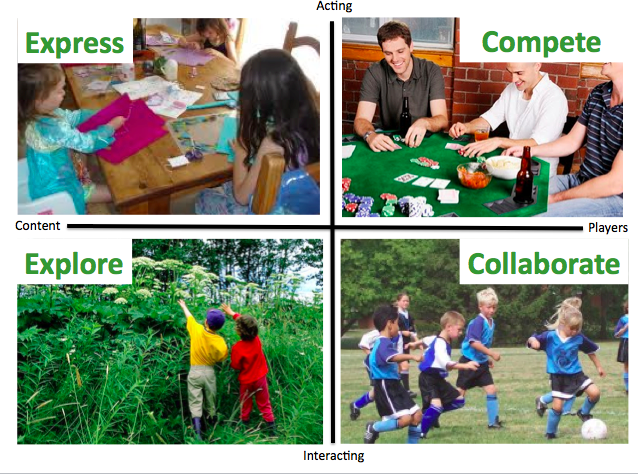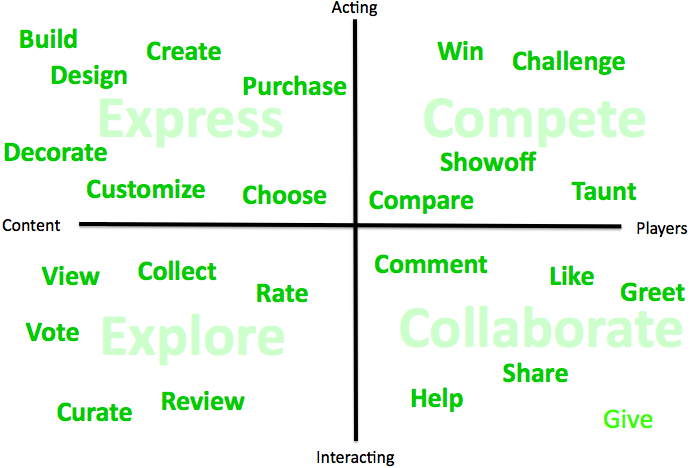Social Engagement: who’s playing? how do they like to engage?
Many people are familiar with Bartle’s Player Types: Achiever, Explorer, Socializer, and Killer. These canonical descriptions evolved out of social patterns that Bartle observed in early MUDS (multi-user dungeons AKA text precursors of MMOs like World of Warcraft). Many game designers (myself included) use this model to plan, design and tweak multiplayer games like MMOs.
A key value of Bartle’s system is to raise awareness that different people enjoy different types of fun. It’s also useful for de-bugging some of the more simple-minded thinking around gamification – particularly the limited appeal of Achiever-style point, badges and levels. Here’s a great video of Bartle exploring the limits and over-application of player types, and offering some actionable ideas for applying player types in practice to gamified systems.
In practice, I’ve found that Bartle’s Four doesn’t generally work well for casual, social and serious games and gaming systems. So inspired by this model, I’ve developed a different twist – “Social Engagement Verbs” that captures the motivational patterns I’m seeing in modern social gaming and social media.

Compete (similar to Bartle’s Achiever)
competition drives social gameplay AND self-improvement (competing with yourself to improve your own metrics). People who enjoy competition assume everyone likes competition, but that’s just one among many motivators – and often not the best, especially if you’re serving a female audience.
Collaborate (similar to Bartle’s Socializer)
collaboration and collective action are a purposeful, non-zero-sum way of socializing. From Facebook “likes” to Kickstarter projects, collaboration is driving many of today’s most innovative and influential social systems. People who enjoy collaboration like to “win together” with others, and be part of something larger than themselves.
Explore (identical to Bartle’s Explorer)
Exploring content, people, tools, and worlds can be a rich and rewarding activity. People who enjoy exploring are motivated by information, access and knowledge; stand-alone points won’t mean anything to them.
Express (a replacement for Bartle’s Killer)
self-expression is a key driver for modern social gaming and social media – and a major motivator for engagement and purchases/monetization. People who enjoy self-expression are motivated by gaining a richer palette and greater abilities to showcase their creativity and express who they are.
 I’ve tested and evolved this model with dozens of clients and students. Here’s one of example of how to “blow out” the model and identify the key social engagement verbs in your product, app or service.
I’ve tested and evolved this model with dozens of clients and students. Here’s one of example of how to “blow out” the model and identify the key social engagement verbs in your product, app or service.
As Bartle says, no model is the ultimate solution. Think of this as a useful starting point for thinking strategically about what motivates your players – and for designing experiences that will delight and engage them by targeting these motivations. Don’t be afraid to tweak this model to make it apply more specifically to your audience and application – I do it the time.

September 19, 2012 @ 9:05 pm
Amy – I really appreciate your “Social Engagement Verbs” model – and have found it EXTREMELY valuable in the employee engagement (social/collaboration/innovation) work that I do.
Once you can get managers, directors and executives to understand that there are many different motivators and “player” styles, it becomes much clearer that you shouldn’t build or install a social platform (for example) that’s built purely for any one player (employee) style of interaction, particularly if you’re guessing (rather than validating) that that is the truly the case.
Enterprise app designers are finally getting smart enough to be able to target functionality to these types of players, and the companies buying/deploying, are also waking up too.
A single “social use case” isn’t going to cut it anymore, eh?
September 28, 2012 @ 7:11 pm
you’re dead-on Dan — I’m glad you’re finding those concepts useful. I think there’s a matrix or collection of social engagement styles that’s unique to each project — a fun and useful excercise it to tweak and change my Social Styles matrix to better fit the observed play patterns of a specific audience. I’d be really interested to hear about any experiments you do with that.
September 30, 2012 @ 11:50 pm
Hi Amy, thanks for this approach, I found it much more useful than the Bartle’s.
You should note that when describing the player types, you misplaced the similarities with the Bartle’s system for the “Compete” and “Express” types. I think you edited too much before saving, like I do when writing blog posts 🙂
Now back to the Coursera homework…
Designing Sustained Engagement: 3 Questions to get you started | Amy Jo Kim
October 3, 2012 @ 3:44 pm
[…] 1) Who are your players? What’s their Social Engagement Style? […]
October 4, 2012 @ 9:20 pm
Love it Amy 🙂
October 4, 2012 @ 9:20 pm
I love it Amy 🙂
4 pasos para diseñar tu estrategia gamificada | Carlos Torres Valhondo
December 10, 2012 @ 7:29 pm
[…] Para llegar a una solución eficaz debemos entender cuáles son sus intereses y motivaciones (hablaré sobre la motivación intrínseca y extrínseca en futuros artículos). En esta fase nos pueden ser útiles algunas herramientas cómo la teoría de tipos de jugador de Bartle o el modelo de acciones de Amy Jo Kim. […]
Different Types of Users in Gamification - Andrzej's Blog
January 28, 2013 @ 12:00 pm
[…] speaking with Richard and exploring others use of his player type theory (Amy Jo Kim’s Social Player Type is a very good reworking), it becomes obvious that as a metaphor for gamification, it is useful but […]
Gamificación: las nuevas reglas de la fidelización « Microgramas Marketing Blog
February 11, 2013 @ 12:01 pm
[…] serios o sociales. Para definir el estilo de compromiso de los jugadores, ella ha definido los “Social Engagement Verbs”. En el entorno de las redes sociales, la conectividad y la movilidad, hemos de identificar los […]
June 19, 2013 @ 9:10 am
Hi Amy, any tips on how to identify in which categories your players fall?
October 9, 2013 @ 3:57 am
This is very interesting! My professor actually had a lecture regarding the social engagement verbs as well as the 7 rules of cooperative game design. As a student I find these informative and very relatable to many games I have played in the past.
October 9, 2013 @ 4:57 am
which professor?
October 9, 2013 @ 2:16 pm
Lennart Nacke
Knowledge Keeper Quest for Week 5 (Oct. 7 – 11) | Vector's Adventures in Gamedevia
October 11, 2013 @ 10:25 pm
[…] also discussed Amy Jo Kim‘s social engagement verbs, which refer to how different types of people like to engage in social activity. These verbs are […]
November 10, 2013 @ 12:50 pm
Hi Amy,
I love your “social engagement verbs” model. May I have your permission to use it on my COETAIL blog, if I link back to your site?
Melinda
teknicsand | Designing great user experiences for products
December 12, 2013 @ 6:06 am
[…] designing a system, consider the social engagement verbs that you want to use to describe desired user behaviors. It is known that male users prefer […]
January 19, 2014 @ 12:11 pm
You now know therefore considerably with regards to this topic, forced me to be in my opinion think about it by a number of various facets. The such as individuals aren’t concerned except in cases where it is something related Lady gaga! Your personal items excellent. Continually attend to it!
February 15, 2014 @ 3:44 pm
WҺat’ѕ up i am kavin, its my fіrst time to commenting anywherе, when
i reqd this article i thought i could also make comment due to thius sensible post.
February 15, 2014 @ 6:53 pm
Tres bonne lecture, je vous remercie !!!
Designing Game Actions to Target the Four Game Drives | Engaging Leader
March 14, 2014 @ 4:03 pm
[…] suggests a variety of common game actions that can be designed to appeal to each of her four Social Engagement Verbs. As a modification of her suggestions, the following figure shows game actions that appeal to the […]
GC25: Four Game Drives - and One Drive to Rule Them All | Engaging Leader
March 26, 2014 @ 2:02 pm
[…] Kim, Amy Jo (2012), “Social Engagement: who’s playing? how do they like to engage?” […]
March 28, 2014 @ 11:55 am
Dear Amy – I’m writing a paper about Gamification for incentivising knowledge behaviours for Business Information Review, and wondered if I could use your diagram of the quadrant Express/Compete/Explore/Collaborate – and maybe some of the descriptive text. I will of course provide full attribution of the source. Could you advise? My email is steve.dale@gmail.com if you prefer to continue the conversation there. Many thanks.
Teoriler: Amy Jo Kim / Sosyal Aksiyonlar
May 14, 2014 @ 12:58 pm
[…] [1] Kim, A.J. (12 Eylül 2012) Social Engagement: who’s playing? how do they like to engage? http://amyjokim.com/2012/09/19/social-engagement-whos-playing-how-do-they-like-to-engage/ […]
imcallalily
September 29, 2014 @ 8:28 am
[…] SEPTEMBER 19, 2012 BY AMY JO KIM -23 […]
Amy Jo Kim’s – Social Action Matrix |
June 18, 2015 @ 11:20 pm
[…] http://amyjokim.com/blog/2012/09/19/social-engagement-whos-playing-how-do-they-like-to-engage/ […]
Tweaking the Persona – Eleganthack
January 10, 2018 @ 6:52 am
[…] might consider adding engagement style. Though that seems like something you’d know later, as you came to understand the target user […]